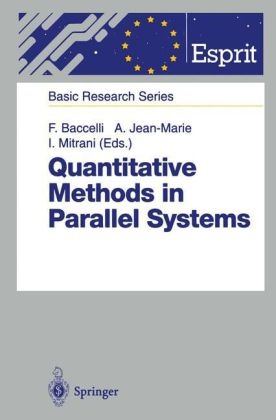Share
Francois Baccelli, Alain Jean-Marie, Isi Mitrani
Quantitative Methods in Parallel Systems
English · Hardback
Description
It is widely recognized that the complexity of parallel and distributed systems is such that proper tools must be employed during their design stage in order to achieve the quantitative goals for which they are intended. This volume collects recent research results obtained within the Basic Research Action Qmips, which bears on the quantitative analysis of parallel and distributed architectures. Part 1 is devoted to research on the usage of general formalisms stemming from theoretical computer science in quantitative performance modeling of parallel systems. It contains research papers on process algebras, on Petri nets, and on queueing networks. The contributions in Part 2 are concerned with solution techniques. This part is expected to allow the reader to identify among the general formalisms of Part I, those that are amenable to an efficient mathematical treatment in the perspective of quantitative information. The common theme of Part 3 is the application of the analytical results of Part 2 to the performance evaluation and optimization of parallel and distributed systems. Part 1. Stochastic Process Algebras are used by N. Gotz, H. Hermanns, U. Herzog, V. Mertsiotakis and M. Rettelbach as a novel approach for the struc tured design and analysis of both the functional behaviour and performability (i.e performance and dependability) characteristics of parallel and distributed systems. This is achieved by integrating stochastic modeling and analysis into the powerful and well investigated formal description techniques of process algebras.
List of contents
I Formalisms.- Stochastic Process Algebras.- 1. Introduction. The Indivisibility of Functional and Temporal Behaviour.- 2. The Roots of Stochastic Process Algebra.- 3. The Stochastic Process Algebra TIPP.- 3.1 Syntax.- 3.2 Semantics.- 3.3 Equivalences.- 3.4 Axiomatisation.- 4. Example. A Multiprocessor with MMPP Arrival Stream.- 4.1 Load modelling.- 4.2 The machine model.- 4.3 Model simplification.- 4.4 Numerical results.- 5. Case Studies.- 6. Tool Support.- 7. Recent Extensions.- 8. Summary and Outlook.- Stochastic Process Algebra for Discrete Event Simulation.- 1. Introduction.- 2. Language.- 3. Semantics.- 4. Strong bisimulation.- 5. Weak bisimulation.- 6. Examples and speculations.- 6.1 Generalised Semi-Markov Processes (GSMP).- 6.2 Two processor queue.- 6.3 Equivalence.- 7. Conclusions.- GSPN and SPA Compared in Practice.- 1. Introduction.- 2. Comparison between GSPN and SPA.- 2.1 Notational level.- 2.2 State versus Action.- 2.3 Compositionality and Equivalences.- 2.4 Abstraction Mechanism.- 2.5 Analysis Techniques.- 2.6 Tool Support.- 2.7 Translation from SPA to GSPN.- 3. A Distributed Electronic Mail System.- 4. Modelling the system.- 4.1 GSPN model.- 4.2 SPA Specification.- 5. Comparing the developed models.- 6. Transforming SPA to GSPN.- 7. Conclusion.- Functional and Performance Analysis of Cooperating Sequential Processes.- 1. Introduction.- 2. Deterministic Systems of Sequential Processes.- 2.1 Basic Definitions and Notations of Petri Nets.- 2.2 Deterministic Systems of Sequential Processes, and Other Subclasses.- 2.3 Time Representation.- 3. Functional Analysis of DSSP s.- 3.1 The Coarse net of a DSSP.- 3.2 Well-Formedness and Liveness.- 4. Performance Analysis of DSSP s.- 4.1 Home States and Ergodicity.- 4.2 Computation of Visit Ratios.- 4.3 Performance Bounds.- II Techniques.- Analysis of Parallel Processing Systems via the (max,+) Algebra.- 1. Introduction.- 2. The Basic Problem.- 3. Modeling via (max, +)-Linear Recurrence Equations.- 3.1 Algebraic Framework.- 3.2 Recurrence Equations.- 3.3 Variations.- 3.4 Canonical Recurrence Equations.- 3.5 Response Times.- 4. Stability.- 4.1 First Order Limits.- 4.2 Second Order Limits.- 4.3 Multiple Stationary Regimes for Closed Systems.- 5. Analytical Results.- 5.1 Markovian Analysis.- 5.2 Taylor Expansions for the M/G Case.- 5.3 Transient and Stationary Distributions for the M/D Case.- 6. Parallel Simulation Issues.- 6.1 Parallel Simulation Algorithms.- 6.2 Minimal Standard Representations.- TIPP and the Spectral Expansion Method.- 1. Introduction.- 2. The Spectral Expansion solution method.- 3. SE-TIPP.- 3.1 Syntax.- 3.2 Semantic model.- 3.3 Construction schema.- 4. Application example.- 4.1 System description.- 4.2 System semantics.- 4.3 System evaluation.- 5. Conclusion.- G-Networks: A Survey of Results, a Solver and an Application.- 1. Introduction.- 2. G-networks with positive and negative customers.- 3. G-networks with signals.- 4. G-networks with signals and batch removals.- 5. The solver tool.- 6. An example: Performance evaluation of receiver initiated load balancing.- 7. Conclusions.- Polling Models with Threshold Switching.- 1. Introduction.- 2. Analytic Solution for the preemptive model.- 3. Analytic Solution for the non-preemptive model.- 4. Power series algorithm.- Two-Dimensional Nearest-Neighbour Queueing Models.- 1. A review.- 2. The symmetrical shortest queueing model.- M/G/1 Queues with FCFS Negative Arrivals.- 1. Introduction.- 2. Derivation of equations defining the generating function.- 3. An iterative algorithm.- 4. Conclusion.- Operational Analysis of Timed Petri Nets and Application to the Computation of Performance Bounds.- 1. Introduction.- 2. Observable quantities and operational laws.- 2.1 Basic operational quantities.- 2.2 Conflict-free nets.- 2.3 General nets with conflicts.- 3. Performance bounds based on operational laws.- 3.1 Extension to TWN s.- 3.2 LPP formulation.- 4. An example of application.- 5. Conclusions.- Approximate Throughpu
Product details
| Assisted by | Francois Baccelli (Editor), Alain Jean-Marie (Editor), Isi Mitrani (Editor) |
| Publisher | Springer, Berlin |
| Languages | English |
| Product format | Hardback |
| Released | 19.02.2009 |
| EAN | 9783540601258 |
| ISBN | 978-3-540-60125-8 |
| No. of pages | 298 |
| Weight | 610 g |
| Illustrations | Illustr. |
| Series |
ESPRIT Basic Research Series ESPRIT Basic Research Series |
| Subject |
Natural sciences, medicine, IT, technology
> IT, data processing
> IT
|
Customer reviews
No reviews have been written for this item yet. Write the first review and be helpful to other users when they decide on a purchase.
Write a review
Thumbs up or thumbs down? Write your own review.

